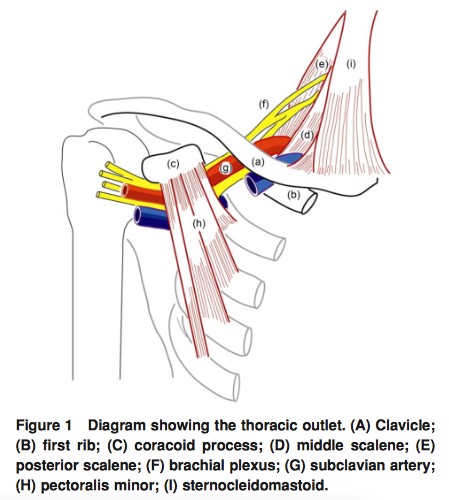By: Meredith Lewis, SPT
You may have been told by your physician or physical therapist that you have thoracic outlet syndrome (TOS). This may seem unfamiliar and might sound like a daunting diagnosis, but in reality it can be a simple condition that is easily resolved with physical therapy. Here is some information on the condition, its causes and symptoms, and what you can do to treat it.
The thoracic outlet: An area of tissue, muscle, and bone from the base of the side of your neck to your shoulder. Many structures are in this very small compartment, and the area decreases in size with arm, neck, and body movements and to when you take deep breaths.1
Thoracic outlet syndrome (TOS): Occurs when those structures start to compress either your nerves or your blood supply.
Causes: TOS is usually caused by repetitive overhead arm movements, such as throwing and reaching. You are also susceptible to developing TOS if you have had trauma to your neck, such as with whiplash.
Symptoms: The most common symptoms of TOS are pain, numbness, and tingling in your arm and hand. You may have noticed a feeling of weakness in one arm compared to the other, especially after lifting or reaching overhead.1 There are three different types of TOS, and each has a different treatment plan that your physical therapist will implement based on your symptoms.
 Neurogenic TOS: Occurs when the nerves that come from your neck are compressed by muscles, bones, or other tissues in between your neck and the shoulder-girdle area. This is by far the most common type of TOS, as 96% of cases are due to nerve compression.1
Neurogenic TOS: Occurs when the nerves that come from your neck are compressed by muscles, bones, or other tissues in between your neck and the shoulder-girdle area. This is by far the most common type of TOS, as 96% of cases are due to nerve compression.1
Arterial TOS: Occurs when the artery that goes from your heart to your arm is compressed and causes decreased blood flow to your arm and hand.1
Venous TOS: Occurs when the vein that takes blood from your hand to your heart is compressed and the blood in your hand is not able to fully return back to your heart.1
Physical therapy: The main exercises you will be performing in clinic include stretches for your neck and shoulder muscles, posture exercises to promote a more upright and proper posture, strengthening exercises for your back muscles to help keep you in that upright posture, and breathing exercises to help you breathe without depending on your neck muscles as much.1
Physical therapists are well trained in the treatment of thoracic outlet syndrome and will help you get back to your normal day-to-day activities with less pain, numbness, and tingling in your arm.
For more information about TOS, please feel free to contact our PTs at [email protected].
Reference:
1. Hooper et al. “Thoracic Outlet Syndrome: A Controversial Clinical Condition.” Part 1: Anatomy, and Clinical Examination/Diagnosis. Journal of Manual and Manipulative Therapy. 2010; 18(2), 74–83.







